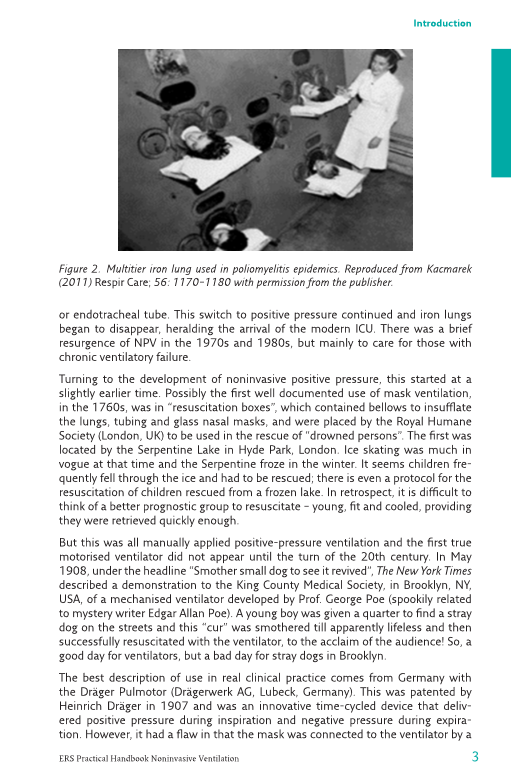3 ERS Practical Handbook Noninvasive Ventilation Introduction or endotracheal tube. This switch to positive pressure continued and iron lungs began to disappear, heralding the arrival of the modern ICU. There was a brief resurgence of NPV in the 1970s and 1980s, but mainly to care for those with chronic ventilatory failure. Turning to the development of noninvasive positive pressure, this started at a slightly earlier time. Possibly the first well documented use of mask ventilation, in the 1760s, was in “resuscitation boxes”, which contained bellows to insufflate the lungs, tubing and glass nasal masks, and were placed by the Royal Humane Society (London, UK) to be used in the rescue of “drowned persons”. The first was located by the Serpentine Lake in Hyde Park, London. Ice skating was much in vogue at that time and the Serpentine froze in the winter. It seems children fre- quently fell through the ice and had to be rescued there is even a protocol for the resuscitation of children rescued from a frozen lake. In retrospect, it is difficult to think of a better prognostic group to resuscitate – young, fit and cooled, providing they were retrieved quickly enough. But this was all manually applied positive-pressure ventilation and the first true motorised ventilator did not appear until the turn of the 20th century. In May 1908, under the headline “Smother small dog to see it revived”, The New York Times described a demonstration to the King County Medical Society, in Brooklyn, NY, USA, of a mechanised ventilator developed by Prof. George Poe (spookily related to mystery writer Edgar Allan Poe). A young boy was given a quarter to find a stray dog on the streets and this “cur” was smothered till apparently lifeless and then successfully resuscitated with the ventilator, to the acclaim of the audience! So, a good day for ventilators, but a bad day for stray dogs in Brooklyn. The best description of use in real clinical practice comes from Germany with the Dräger Pulmotor (Drägerwerk AG, Lubeck, Germany). This was patented by Heinrich Dräger in 1907 and was an innovative time-cycled device that deliv- ered positive pressure during inspiration and negative pressure during expira- tion. However, it had a flaw in that the mask was connected to the ventilator by a Figure 2. Multitier iron lung used in poliomyelitis epidemics. Reproduced from Kacmarek (2011) Respir Care 56: 1170–1180 with permission from the publisher.
